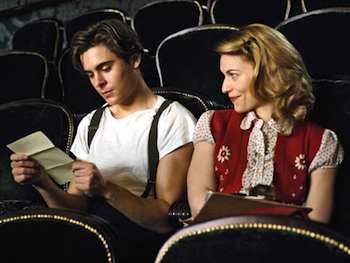- MENU
- HOME
- SEARCH
- WORLD
- MAIN
- AFRICA
- ASIA
- BALKANS
- EUROPE
- LATIN AMERICA
- MIDDLE EAST
- United Kingdom
- United States
- Argentina
- Australia
- Austria
- Benelux
- Brazil
- Canada
- China
- France
- Germany
- Greece
- Hungary
- India
- Indonesia
- Ireland
- Israel
- Italy
- Japan
- Korea
- Mexico
- New Zealand
- Pakistan
- Philippines
- Poland
- Russia
- South Africa
- Spain
- Taiwan
- Turkey
- USA
- BUSINESS
- WEALTH
- STOCKS
- TECH
- HEALTH
- LIFESTYLE
- ENTERTAINMENT
- SPORTS
- RSS
- iHaveNet.com: Movie Reviews

A real charmer, "Me and Orson Welles" is the work of a director who takes nostalgia, romantic possibility and the theater seriously, without being a pill about it.
Richard Linklater's film version of the Robert Kaplow novel tells a fairy tale based in fact.
Strolling the Manhattan theater district one day in
1937, the story's fictional protagonist, a New
Jersey high school student played by Zac
Efron, stumbles into Orson Welles,
John Houseman and their
In an eye-blink, young Richard is hired to play the lute-strumming role of Lucius in Welles' modern-dress revival of "Julius Caesar," opening in a mere week.
These were history-making times for Welles. Already in 1937 the impresario's involvement with the incendiary musical "The Cradle Will Rock" (Tim Robbins made a rather hectoring film about it) burnished the Wellesian reputation for nerve and publicity. Welles' "Julius Caesar," drawing eerie parallels with Mussolini's regime, featured actors Welles would use later in Hollywood, ranging from panicky Brit George Coulouris (played in Linklater's film by Ben Chaplin) to elegant Virginia horn-dog Joseph Cotten (James Tupper). "Me and Orson Welles" has Richard falling for the Mercury's jill-of-all-trades, Sonja, played by Claire Danes. Her character is neither a simple ingenue nor a vamp. Danes, reliably excellent, creates a woman of ambition as well as heart.
The film's press so far has focused on Christian McKay's portrayal of Welles, and it is indeed something to see. Even more so, to hear: McKay (who is British, and a fair bit older than was 22-year-old Welles in 1937) gives us a boy-man who, practically since birth, has been told he is a genius with a fantastically expressive voice, and who uses that voice for theatrical effect even when he's nowhere near a stage. The script by Holly Gent Palmo and Vince Palmo stays true to novelist Kaplow's source material, setting Welles up as the maelstrom who wises up a teenager and then whirls onward.
Much of the film was shot on the Isle of Man, with bits of London filling in for Depression-era Manhattan. Not since Mike Leigh's Gilbert and Sullivan portrait "Topsy-Turvy" (1999), detailing the birth of "The Mikado," has a film devoted so much screen time to the ins and outs of theatrical endeavor so rewardingly. (Cinematographer Dick Pope, a master at evocative interior lighting, worked on both pictures.) This theatrical bent may be surprising given director Linklater's resume; then again, the resume in question is one of the most unpredictable in contemporary American cinema, zigzagging from the hazy Texas ambience of "Slacker" and "Dazed and Confused" to the quiet, piquant marvels "Before Sunrise" and "Before Sunset" to "The School of Rock" and "Fast Food Nation."
Working on a modest budget, Linklater manages some lovely visual
flourishes, my favorite being a tracking shot that scurries, puppylike,
after Welles as he rushes from theatrical rehearsal to a radio gig at
MPAA rating: PG-13 (for some sexual references and smoking).
Running time: 1:53.
Cast: Zac Efron (Richard Samuels); Claire Danes (Sonja Jones); Christian McKay (Orson Welles); Ben Chaplin (George Coulouris); Zoe Kazan (Gretta Adler); Eddie Marsan (John Houseman); James Tupper (Joseph Cotten); Kelly Reilly (Muriel Brassler).
Credits: Directed by Richard Linklater; written by Holly Gent Palmo and Vince Palmo, based on the book by Robert Kaplow; produced by Linklater, Marc Samuelson and Ann Carli. A Freestyle Releasing release.
Me and Orson Welles Movie Review - Zac Efron & Claire Danes